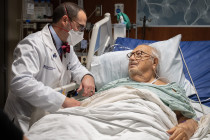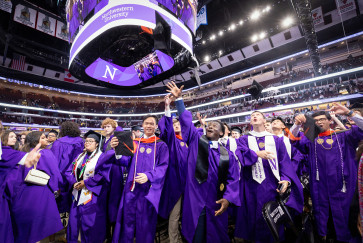“Every day, there’s more information coming out about technology and AI, and the more that people use these tools, the more they realize the primary information we get from patients during the history and physical exam is increasingly critical to the decisions we make. There’s only so much tech can do without the correct inputs from humans — both physicians and patients.”
“Dedicating part of an education series to these issues underscores the recognition of the value of these skills,” said Garibaldi, the Charles Horace Mayo Professor of medicine in the division of pulmonary and critical care at Northwestern University Feinberg School of Medicine. “If we don’t intentionally cultivate them, they’re at risk of being lost.”
Six ways to reinvigorate the bedside encounter
- Go to the bedside and observe: Observing a patient from the foot of the bed, or even from the hallway, reveals clues that are critical to understanding a patient’s diagnosis, prognosis and personal circumstances, the report says.
- Practice and teach an evidence-based approach to the physical exam: Medical students often learn to do physical exams from head to toe, which can lead doctors to rely more on tests and technology. A better approach is the hypothesis-driven physical exam in which each exam step is chosen based on what the doctor suspects might be wrong using the patient’s history and knowledge of common illnesses to estimate the likelihood of a diagnosis.
- Create opportunities for intentional practice: Patient-centered medical education conducted with learners and teachers at the bedside during rounds can increase efficiency and enhance physician satisfaction. Bedside sessions should start early on in medical school since habits form early and influence a physician’s practice throughout their career.
- Use technology to teach and reinforce exam skills: AI-enabled bedside medicine is still taking shape, but the results from AI interactions should always inform rather than replace human observation, human clinical decision-making and human communication at the bedside.
- Seek and provide feedback on clinical skills: Delivering feedback to learners in the presence of patients is a complex skill, especially if it involves correcting a mistake in exam technique or modifying the diagnosis or treatment plan. Poorly delivered feedback could undermine the relationship between the trainee and patient. But if delivered in a thoughtful way, bedside feedback can reassure the patient that the entire team is invested in their care.
- Acknowledge the power of the bedside encounter beyond diagnosis: Uncertainty is a part of bedside patient care. But curiosity can mitigate uncertainty and help patients, clinicians and trainees negotiate the uncertainty together, strengthening the patient-physician relationship. Also, the bedside encounter can address health care disparities.
By employing these strategies, clinical educators can help trainees appreciate the value of the bedside encounter in diagnostic reasoning, strengthen the patient-physician relationship, combat health care inequities, and improve professional fulfillment and burnout, the report said.
Listen to the Breakthroughs podcast: Dr. Brian Garibaldi discusses how modern technology integrates with traditional clinical skills >
The words of master clinician educator Sir William Osler ring true over a century later, the report reads: “Medicine is learned by the bedside and not in the classroom. Let not your conceptions of the manifestations of disease come from words heard in the lecture room or read from the book. See, and then reason and compare and control. But see first.”
“From an educational standpoint, the best way to learn about patients is to be with them,” said Dr. Stephen Russell, a physician and professor in the University of Alabama at Birmingham’s division of general internal medicine and population science. “Each of these six steps was crafted under the mindset of finding ways to get doctors out of the conference room and hallways and back to the bedside where their patients are located.”



